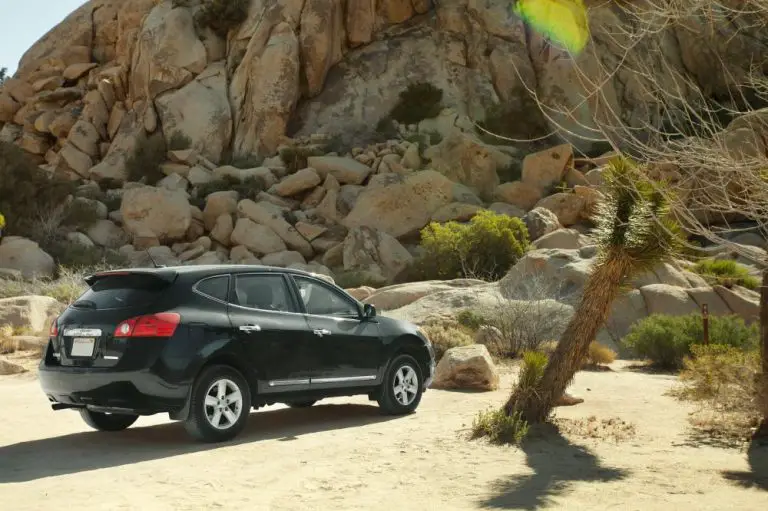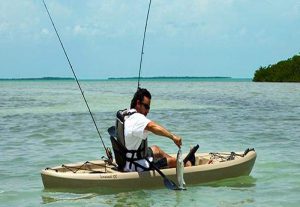So, you’ve just shelled out a week’s salary for a sweet kayak setup, complete with ergonomic paddle and regulation PFD. The trouble is, you don’t have any spare cash left over to invest in a roof rack. So, unless you live directly on a body of water, you’ll have to come up with a more creative way to get your new toy from Point A to Point B.
We’ve all been there. Fortunately, we managed to pull it off. All you need is a sturdy length of rope and a bit of ingenuity, not to mention basic knot-tying skills. Teamwork doesn’t hurt either, but you can also manage the task alone, as long as you’re careful. Read on to learn more about how to transport a kayak without a roof rack.
Method #1: The Pickup Be

If you have a pickup truck, you’re already several steps ahead of the game. Smaller kayaks—like the ones designed for use in rivers with Class IV-V rapids—can slide easily into the truck bed, no extra work required. For best results, position the boat so that the cockpit faces downward. If your truck allows for this configuration, try positioning the paddle directly over the center of the kayak (forming a cross shape) for added security.
Larger and bulkier crafts—lake and stream models—may need to be tied down before you set off. Position the boat so that the stern is situated in the front left corner of the truck bed, with the bow facing the back right corner. If you have cam buckle straps, use these for the next steps; if not, two generous lengths of sturdy rope will work fine. One length should run parallel to the truck’s tailgate, across the top of the cockpit of the kayak. Affix the ends to the truck’s anchor points on either side. Then run a second length from the tow loop to the bed anchor, pulling on the ends to tighten the rope before tying it down. Note that this method only works if your kayak measures less than 11 feet in length.
If you’re planning on leaving your kayak-laden truck unsupervised for a period of time, it’s a good idea to invest in a locking cable run to protect against theft. Finally, remember to tie a brightly colored flag or T-shirt (red or orange) to the bow, to ensure that the potential hazard can be seen by other drivers. This step is required by law if the load protrudes more than 3 feet off the end of the vehicle, so don’t be tempted to skip it.
Method #2: The Noodle

This method works best with SUVs or crossover vehicles, but it will also work with smaller vehicles as long as the kayak doesn’t extend more than a foot or so off the roof in either direction.
To pull this one off, you’ll need three “pool noodles”—long, flexible foam cylinders that are typically used as recreational floatation devices. If you don’t already have a few of these on hand, they can be purchased at department stores, dollar stores, or supermarkets for under $5. Make sure the noodles are thick, durable, and long enough to cover the width of your vehicle’s roof. If they’re too long, trim the ends until they’re more or less flush with the edges of the roof.
Position the noodles crosswise, spacing them so they’re about three feet apart. There should be one in the front, another in the back, and a third in the center. Next, run ratchet straps or lengths of rope through the hollow center of each noodle and loop these through the interior of your car through the open doors. Tie the ends securely, tugging lightly on the noodles to ensure that they’re affixed properly.
To load the boat, close the front and rear doors. Lift the kayak, flipping it so that the cockpit is facing down. Position it across your makeshift “rack” with the cockpit resting over the center noodle. If you have a larger touring kayak, this task goes much more smoothly with two people.
Open the car doors again to tie the kayak in place. Use additional ratchet straps or lengths of rope to secure the boat to the makeshift rack. If you’re using straps, twist them so that they’ll make less noise during the trip. Make sure they’re buckled tightly enough to keep the boat secure, but not so tight as to damage the hull or the roof of your car.
You can also use a single length of sturdy rope for this, provided it’s long enough to get the job done. Just string the rope through the kayak carrying loop on the bow, then pass it through the interior of the vehicle and out over the roof several times. Finish by repeating the same process with the carrying loop on the stern before securing the ends. You can tie the ends to the ropes or straps that are keeping the noodles in place, or use the tie-down spots that are located underneath your vehicle.
Method #3: The SUV Luggage Rack
Most of the SUVs sold on the current market will feature some sort of luggage rack on the roof, even if it’s just a standard set of side rails. If you drive an SUV and it has side rails but no crossbars, you’re better off following the pool noodle method.
If the crossbars are in place, however, there’s no need to invest in the noodles at all. The kayak won’t be sitting directly on the roof, so you don’t need to worry about damaging the paint job or the hull of your boat.
Simply follow the same procedure that’s outlined in the pool noodle method, positioning the kayak with the bow facing down. When you’re passing the rope over the top of the kayak to secure it, loop it through the side rails instead of through the interior of the vehicle. This will save you a great deal of rope, thereby allowing for a more secure fit.
Method #4: The Trunk

You’ve probably seen this no-frills method in action: A kayak protruding from the trunk of a vehicle, making it look like a fish that’s lost one fin. While it’s not pretty by any means, it might work in a pinch, especially if your kayak is one of the shorter, sporty models.
First, check to make sure the configuration of your trunk will allow for a load this size. In some models, the rear seats are positioned too far back, making this method a no-go.
Slide the kayak in bow first, with the cockpit facing down. If the stern protrudes more than six feet beyond the bumper, you’ll have to choose another method. If it rests securely with fewer than six feet protruding, run a ratchet strap or length of rope through the rear carry strap and secure the ends to the tie-down spots located under your vehicle. Use a second strap to tie the roof down, taking care not to damage the hull. Don’t forget to tie the red flag to the stern before setting out.
You don’t have to invest in pricey equipment to embark on your maiden voyage. Now that you know how to transport a kayak without a roof rack, you can head out as soon as the weather permits. Happy trails!






